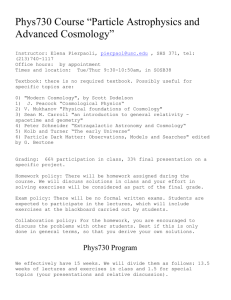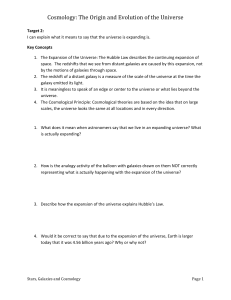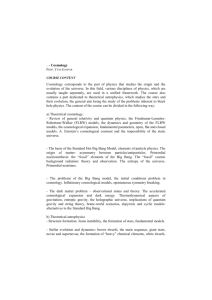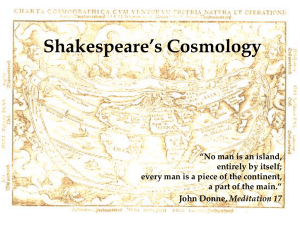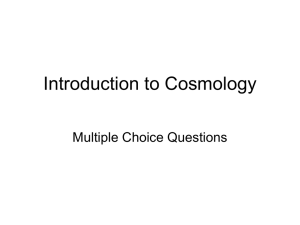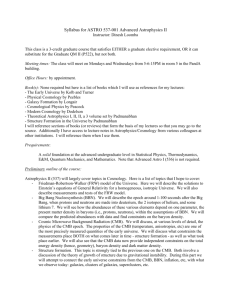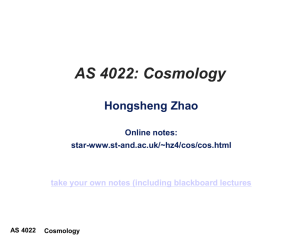Why Study Cosmology? - Astronomy Group | University of St Andrews
advertisement
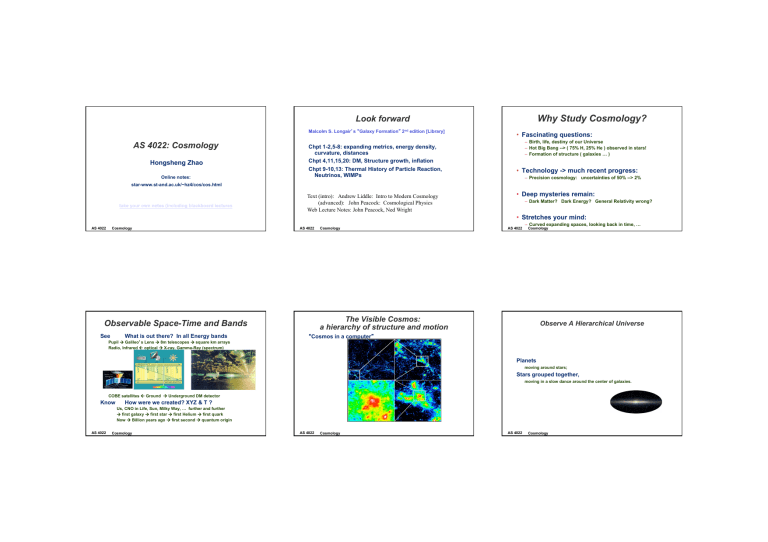
Why Study Cosmology? Look forward Malcolm S. Longairʼs “Galaxy Formation” 2nd edition [Library] AS 4022: Cosmology Hongsheng Zhao and you will be the 1st, and you will be the 1st, Online notes: Chpt 1-2,5-8: expanding metrics, energy density, curvature, distances Chpt 4,11,15,20: DM, Structure growth, inflation Chpt 9-10,13: Thermal History of Particle Reaction, Neutrinos, WIMPs • Fascinating questions: – Birth, life, destiny of our Universe – Hot Big Bang --> ( 75% H, 25% He ) observed in stars! – Formation of structure ( galaxies … ) • Technology -> much recent progress: – Precision cosmology: uncertainties of 50% --> 2% star-www.st-and.ac.uk/~hz4/cos/cos.html take your own notes (including blackboard lectures Text (intro): Andrew Liddle: Intro to Modern Cosmology (advanced): John Peacock: Cosmological Physics Web Lecture Notes: John Peacock, Ned Wright • Deep mysteries remain: – Dark Matter? Dark Energy? General Relativity wrong? • Stretches your mind: AS 4022 Cosmology AS 4022 What is out there? In all Energy bands AS 4022 – Curved expanding spaces, looking back in time, … Cosmology The Visible Cosmos: a hierarchy of structure and motion Observable Space-Time and Bands See Cosmology Observe A Hierarchical Universe “Cosmos in a computer” Pupil Galileoʼs Lens 8m telescopes square km arrays Radio, Infrared optical X-ray, Gamma-Ray (spectrum) Planets moving around stars; Stars grouped together, moving in a slow dance around the center of galaxies. COBE satellites Ground Underground DM detector Know How were we created? XYZ & T ? Us, CNO in Life, Sun, Milky Way, … further and further first galaxy first star first Helium first quark Now Billion years ago first second quantum origin AS 4022 Cosmology AS 4022 Cosmology AS 4022 Cosmology 1 Cosmic Village The Milky Way and Andromeda galaxies, along with about fifteen or sixteen smaller galaxies, form what's known as the Local Group of galaxies. The Local Group sits near the outer edge of a supercluster, the Virgo cluster. Hubble Deep Field: At faint magnitudes, we see thousands of Galaxies for every star ! Galaxies themselves some 100 billion of them in the observable universe— form galaxy clusters bound by gravity as they journey through the void. But the largest structures of all are superclusters, each containing thousands of galaxies and stretching many hundreds of millions of light years. are arranged in filament or sheet-like structures, between which are gigantic voids of seemingly empty space. the Milky Way and Andromeda are moving toward each other, the Local Group is falling into the middle of the Virgo cluster, and ~1010 galaxies in the visible Universe ~1010 stars per galaxy ~1020 stars in the visible Universe the entire Virgo cluster itself, is speeding toward a mass known only as "The Great Attractor." AS 4022 AS 4022 Cosmology Cosmology Today! Cosmology AS 4022 Cosmology Introducing Gravity and DM (Key players) Accelerating/Decelerating Expansion These structures and their movements can't be explained purely by the expansion of the universe must be guided by the gravitational pull of matter. Visible matter is not enough one more player into our hierarchical scenario: dark matter. AS 4022 Cosmology AS 4022 Cosmology 2 Looking Back in Time Cosmologists hope to answer these questions: main concepts in cosmology • Blah How old is the universe? H0 Why was it so smooth? P(k), inflation Expansion & Metric Cosmological Redshift Energy density How did structures emerge from smooth? N-body How did galaxies form? Hydro Will the universe expand forever? Omega, Lamda Or will it collapse upon itself like a bubble? AS 4022 AS 4022 Cosmology A few mins after New Year Celebration at Trafalgar Square AS 4022 Cosmology 1st concept Metric: ant network on expanding sphere Feb 14 t=45 days later D2 D1 He C1 He C2 Cosmology D3 3. C3 3 R(t) B2 chi+dchi A2 4 B3 Walking ↔ Elevating ↔ Earth Radius Stretching R(t ) AS 4022 Cosmology dl 2 = [R(t )d# ] + [R(t ) sin #d" ] A1 ! B2 2 A3 AS 4022 Cosmology ) 1with (χ,φ ,3,4 tes 1,2 ina y s d b r r ve oo en ser giv 2 , g) cRadius es 1 tal ob Expanding vin l n mo anc 2 dt2 -d R(t) t e s o i d c dam ular (c es, ds2 = r 2) e Fun g φ an sph ime t 2 χd ed t ing n Fix and osmic 2 + si p x c e (dχ on ric at 2 t) t R( Me 2 = dl Angle φ1 4 phi+dphiB1 A1 Homogeneous Isotropic Universe 2 2 Angle χ1 AS 4022 Cosmology 2 3 Stretch of photon wavelength in expanding space 2nd main concept: Cosmological Redshift Redshift! • Expansion is a stretching of space. • The more space there is between you and a galaxy, the faster it appears to be moving away. • Expansion stretches the wavelength of light, causing a galaxy’s spectrum to be REDSHIFTED: Emitted with intrinsic wavelength λ0 from Galaxy A at time t<tnow in smaller universe R(t) < Rnow The space/universe is expanding, Galaxies (pegs on grid points) are receding from each other As a photon travels through space, its wavelength becomes stretched gradually with time. Photons wave-packets are like links between grid points This redshift is defined by: STATIONARY: DOPPLER SHIFT: z# REDSHIFT: Received at Galaxy B now (tnow ) with λ λ / λ0 = Rnow /R(t) = 1+z(t) > 1 AS 4022 AS 4022 Galaxy Redshift Surveys ~50Mpc. Hubble’s law appears to violate Copernican Principle. we at a special location? 2. Filaments where walls intersect. 3. Clusters where filaments intersect. Like Soap Bubbles ! AS 4022 Cosmology The Are z=0 Hubble law : V = H0 d Hubble "constant": H0 ≈ 500 km s −1Mpc−1 V (km/s) Galaxies are in 1. Walls between voids. 2dF galaxy redshift survey Cosmology Universal Expansion! Isotropic Expansion z = 0.3 Large Scale Structure: Empty voids ! = 1+ z !o REDSHIFT IS NOT THE SAME AS DOPPLER SHIFT Cosmology ! " !o !o Milky Way d (Mpc) Why WRONG? Extinction by interstellar dust was not then known, giving incorrect distances. Is everything moving away from us? 4 Universal Expansion! The Universal Expansion Q : What is so special about our location ? A : Nothing ! Me You • An observer in any galaxy sees all other galaxies moving away, with the same Hubble law. • Expansion (or contraction) produces a centre-less but dynamic Universe. E.g. Consider a quasar with redshift z=2. Since the time the light left the quasar the universe has expanded by a factor of 1+z=3. At the epoch when the light left the quasar, the distance between us and Virgo (presently 15Mpc) was 5Mpc. the CMB temperature then (presently 3K) was 9K. the quasar appears receding with Doppler speed V=2c. The quasar appears at a look-back “distance” d = [t(0)-t(z)] c, where the look-back time [t(0)-t(z)] ~ z/H0 at small z<<1, H0-1=Taylor expansion coeff. v According to Hubble’s Law: I see: 3v You see: 2v v 2v v !now ! (t ) R = now R(t ) T (t ) = Tnow 1+ z = 3v v AS 4022 Cosmology AS 4022 (wavelength) (expansion factor) (Photon Blackbody T " 1/ ! , why ? ) Cosmology We all see the same Hubble law expansion. Hubble Law typical age (at z=1)! V = H0 d t0 ≈ d 1 = V H0 ⎛ 1 Mpc ⎞⎛ 3 ×1019 km⎞⎛ 1 yr ⎞ =⎜ ⎟⎜ ⎟⎜ 7 ⎟ ⎝ 72 km/s ⎠⎝ Mpc ⎠⎝ 3 ×10 s ⎠ ≈13 ×10 9 yr =13 Gyr. d Slope = c Convert H as a frequency Hertz, find an integer close to log10(H)? Multiple choices -30, -10, 0, 10, 30. Look back t0-t 3rd concept: The changing rate of expansion Newtonian Analogy: Consider a sphere of radius R(t) , effective mass inside M = 4πρ R3/3 if energy density inside is e=ρ(t) c2. On this expanding sphere, a test m Kin.E. + Pot.E. = const Energy m (dR/dt)2/2 – G m M/R = (-k/2)m c2 (dR/dt)2 /(2c2) – (4πG/3)ρR2/c2 =-k/2 Unitless k <0, =0, >0 open-flat-close Newtonian expansion satisfies H2 = (dR/dt/R)2 = (ρ + ρcur) (8πG/3) the cst k absorbed in “density” ρcur (t) = -k(cH0-1/R)2 (3H02/8πG) ~ -k R-2 * cst Now H = H0 AS 4022 Cosmology 5
